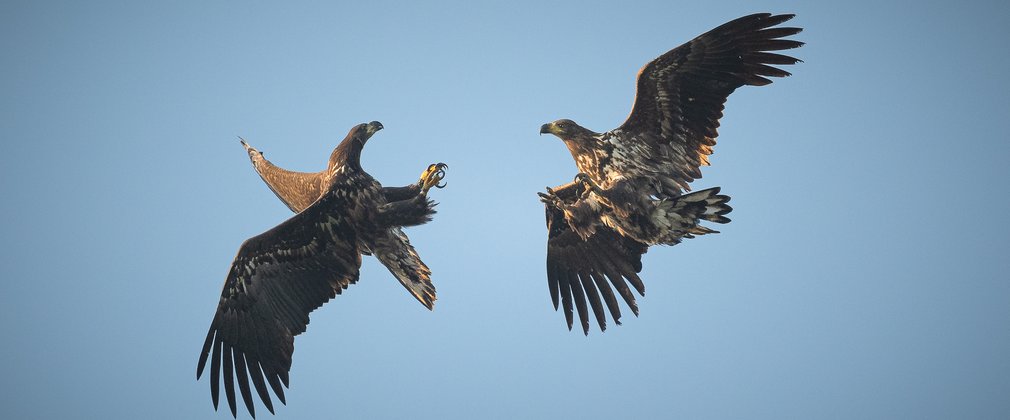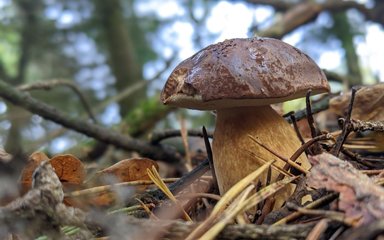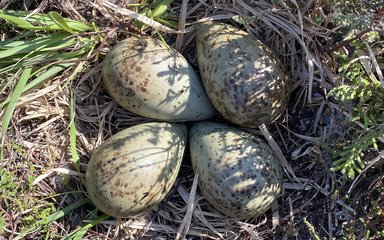
In the latest of our regular updates from Steve Egerton-Read, our white-tailed eagle project officer, we hear of the successful second release of young birds on Isle of Wight and find out what last year's cohort are getting up to.
To say this year has been a challenging one for us all is perhaps an understatement! It has also been a tough year for nature and so many important conservation projects have been stalled or put on hold. Despite this, I am really pleased to report that the partnership project between Forestry England and the Roy Dennis Wildlife Foundation to reintroduce white-tailed eagles to England has been able to continue. It’s great, at a time like this, to share something positive with an update on how the birds have been faring over recent months.
A successful summer
Earlier this summer we successfully released seven more young white-tailed eagles on the Isle of Wight. They join four birds from last year’s release, the project hopes to release up to 60 birds over five years.
The process is of course about much more than just releasing the birds. It starts with the eagle chicks being carefully translocated under licence from Scotland to us here on the Island. When they arrive, we attempt to mimic a wild nest as closely as possible, using specially built aviaries and providing them with food without them having any human contact. It is really important they don’t associate humans with food, and we go to great lengths to achieve this.
The process of leaving or 'fledging' the aviaries also mimics the way things would work in the wild. The doors of their aviaries are slowly and carefully opened, and they choose when they are ready to leave. Some are immediately keen to explore whilst others take the time they need.
Once released, we continue to provide food for the birds, much in the same way that their parents would. Gradually the juvenile eagles become less dependent on this food and more confident to travel further afield. This year’s group also have the advantage of watching the birds released the previous year, learning through observing these older birds’ behaviours.
The last couple of months have been fascinating as we watch the newly released birds begin to explore the island and beyond.

The class of 2019
In addition to this year’s release we have been busy over the last few months in closely monitoring the progress of the birds released in 2019. It is great to see four of the six birds released last summer doing so well. They have all made remarkable journeys through the spring and you can find out more about these on our project partner's website roydennis.org. Often what is most fascinating about their travels is not so much where they went but what they did during their journeys.
It has been fantastic to see bird G3-24 return to the Isle of Wight following two months in south-east Scotland. She spent much of last winter on the island with another of the older birds, G2-74, and the two are socialising again now she has returned. She is also getting to know the newly released birds, observing them and spending time in the same areas.
This is in many ways what we would expect to see. Young white-tailed eagles are sociable, quarrelling over food from time to time but otherwise tolerant of one another and can have communal roosts. However once they reach maturity, at around four or five years old, things change considerably and territory disputes can be fatal.
To get an idea of how the birds behave here in southern England, and why it is a perfect location to base the reintroduction, we can look at the experience of bird G2-74. He has stayed relatively local throughout the summer and we have been able to observe a lot of what he has been up to. He has been regularly catching grey mullet in the Isle of Wight estuaries and during poor weather he heads inland catching rabbits.
Perhaps the greatest surprise is his taste for cuttlefish; he easily plucks them from the surface of the Solent. The Solent is an important spawning ground for these fascinating creatures and you can see evidence of their arrival on many island beaches; once they spawn they die and you find their carcasses washed up or the tell-tale ‘bone’. In recent weeks he has also become adept at catching gulls, chasing down the weak or sick birds.

Preparing for winter
Of course, winter can be a challenging time for the young eagles and their first winter is often the hardest. Unfortunately, it is likely that some of the newly released birds may not survive. Based on similar reintroductions we expect around 30-40% to make it to adulthood. Many causes of death are natural, but sadly one bird, G4-53, died this autumn following a collision with a power line. Young and inexperienced birds can make mistakes and things like this do happen from time to time, but we hope that as many of the birds as possible will go on to survive and thrive in their environment.
As the autumn progresses into winter, we can expect to see some of the newly released juveniles start to explore further afield. Some of them have already begun to do this; G4-61 has circumnavigated the south-east coastline, and G4-71 and G4-63 have both made journeys exploring the Dorset, Devon and Cornish coastlines.
This behaviour is normal for juvenile white-tailed eagles. These first few years are all about them learning new skills and developing an understanding of the wider landscape. As they do not reach breeding maturity until they are four or five years old, its only at this point that we expect them to return more permanently to the south of England to set up their territories.
With the birds expected to start exploring further afield over the coming months, you may be lucky enough wherever you are in the country to experience one of them flying across your local skies. We closely monitor the birds using satellite tracking devices so we know where they are and can plot their journeys, but it’s always great to receive images and news of sightings of the birds from the public. These can be shared with us via an online reporting form on roydennis.org or via social media (details below) where you can also follow all our updates on the project.
Spotted a white-tailed eagle?
Share your sightings with the project team.
Instagram: @SeaEagleEngland
Twitter: @SeaEagleEngland and @RoyDennisWF
Web: Online reporting form





